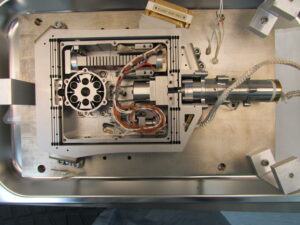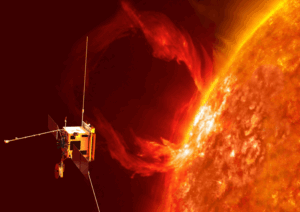The ESR Space team is excited to share that ESA’s Solar Orbiter mission has captured the first-ever images of the Sun’s south pole, an important milestone in solar observation. ESR contributed to this achievement through its involvement in the spacecraft’s critical instrumentation.
The latest images returned to Earth by ESA’s Solar Orbiter reveal the Sun’s dynamic atmosphere and complex magnetic activity in remarkable detail. Behind these visuals, however, is a precision-engineered mechanism developed by specialists at ESR Space, responsible for accurately positioning the primary mirror of one of the spacecraft’s key instruments, SPICE.
Precision Mechanisms for a Mission Like No Other
The Solar Orbiter remains a significant mission in solar research, designed to capture high-resolution data from unique vantage points near the Sun, including its polar regions.. Central to the spacecraft’s capabilities to observe the Sun is a collection of instruments, among them is the spectral imager, SPICE. The SPICE instrument analyses the Sun’s layered structure by detecting light at precise frequencies emitted by elements such as hydrogen, carbon, and magnesium.
ESR Space developed the mechanism responsible for positioning the SPICE instrument’s primary mirror. This mechanism enables fine adjustments during the mission, allowing scientists to adjust the focus of the instrument during the orbit and scan the mirror to allow observations of different parts of the solar surface. This is all achieved in the harsh thermal and radiation environment near the Sun.
Supporting Solar Observation and Data Collection
While the Sun sustains life on Earth, its activity also poses potential risks to modern infrastructure. Solar storms, driven by complex magnetic activity, can disrupt satellite operations, affect communication systems, and impact power grids. Gaining a better understanding of the timing and behaviour of these events is essential.
Until now, scientists lacked crucial data on how the Sun’s magnetic fields migrate and flip at the poles; a process that happens roughly every 11 years and triggers periods of intense solar activity. Solar Orbiter’s direct observations of the Sun’s polar regions are now providing researchers with crucial data that was previously unavailable.
A Collaborative Achievement
The success of the Solar Orbiter mission highlights the strength of European collaboration and engineering capability. For ESR Technology, its involvement reflects not only a significant technical contribution but also a continued commitment to supporting space science and innovation.
As missions like Solar Orbiter progress, with the support of engineering partners such as ESR, they provide valuable foundations for the future of solar research and observation.
Could ESR Technology help you? Get in touch today via email info@esrtechnology.com or via our website contact page.

